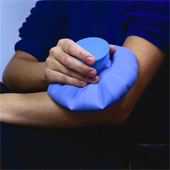 Tendonitis is a common complaint treated in my Neuromuscular Therapy center Southwest of Boston.
Tendonitis is a common complaint treated in my Neuromuscular Therapy center Southwest of Boston.
Tendonitis means inflammation of a tendon. A tendon is the fibrous tissue that connects a muscle to a bone. The muscle contracts (shortens) to move that bone. When a muscle is too tight, it pulls on the tendons which can result in tiny tears that cause inflammation and pain.
Standard care in medicine advocates treatment of the tendon to reduce inflammation and pain, but pays little attention to the muscle to which it’s connected. It makes sense to me to treat the muscle so that, as it relaxes and lengthens, it releases the tension on the tendon and stops the tearing. My point is, that you can treat the tendon all day long and it won’t cure the tendonitis until you treat the muscle that is pulling on it!
With chronic tendonitis from overuse, the attachment site builds scar tissue as it heals each tear. Scar tissue is binding. As it builds up, it increasingly restricts movement and causes more injury as it tries to protect itself.
Muscles and tendons heal differently. Muscles are filled with blood vessels that bring nutrients, oxygen and cells that build and heal the tissue. Tendons have a very limited blood supply so they heal more slowly. Since blood also functions to take away the heat from inflammation as well as the waste products that cause pain, the lack of vascularization also increases the time it takes to reduce pain in a tendon.
It is important to calm inflammation as quickly as possible in spite of the fact that, in the beginning, inflammation is helpful. Prolonged inflammation can cause it’s own problems. Ice is effective applied locally for a few minutes at a time. This newer icing procedure makes sense because, to promote healing, you need to create change in the tissue. Short applications of ice flush blood through the capillary beds under the skin and speed that process. Prolonged icing slows blood flow and makes the tendon stiffer, slowing the healing process.
Stretching is the companion of ice. Gentle stretches, held for only two seconds and repeated multiple times, rub the fibers of the tendon together and stimulate healing.
Manual therapy, pressing on the soft tissue to reduce tension and using slow gliding strokes toward the heart to move fluids along, is also necessary to maintain muscle health and length as the tendon heals.